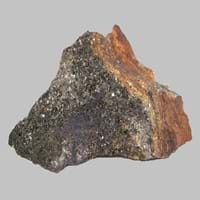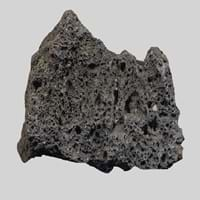Definition
Hornfels is a metamorphic rock formed by the contact between mudstone or other clay rich rock, and a hot igneous body, and represents a heat altered equivalent of the original rock
Scoria is a dark-colored extrusive igneous rock with abundant round bubble-like cavities
Origin
New Zealand
Unknown
Discoverer
Unknown
Unknown
Etymology
From German which means hornstone
From late Middle English (denoting slag from molten metal), from Greek skōria refuse, from skōr dung
Class
Metamorphic Rocks
Igneous Rocks
Sub-Class
Durable Rock, Soft Rock
Durable Rock, Medium Hardness Rock
Group
Not Applicable
Volcanic
Other Categories
Fine Grained Rock, Opaque Rock
Fine Grained Rock, Opaque Rock
Texture
Granular, Platy
Vesicular
Color
Brown, Dark Greenish - Grey, Green, Reddish Brown
Black, Brown, Dark Grey to Black, Red
Durability
Durable
Durable
Appearance
Dull
Glassy and Vesicular
Interior Uses
Decorative Aggregates, Flooring, Homes, Interior Decoration
Decorative Aggregates, Interior Decoration
Exterior Uses
As Building Stone, As Facing Stone, Garden Decoration, Office Buildings, Paving Stone
Garden Decoration, Paving Stone
Other Architectural Uses
Curbing
Curbing
Construction Industry
for Road Aggregate, Roadstone
Cement Manufacture, Construction Aggregate, for Road Aggregate, In landscaping and drainage works
Medical Industry
Not Yet Used
Not Yet Used
Antiquity Uses
Artifacts, Monuments
Artifacts, Monuments, Sculpture
Commercial Uses
Cemetery Markers, Commemorative Tablets, Creating Artwork
As a traction material on snow-covered roads, Creating Artwork, High-temperature insulation, In gas barbecue grills
Types
Biotite hornfels
Not Available
Features
Smooth to touch
Available in Lots of Colors and Patterns, Generally rough to touch, Surfaces are often shiny
Archaeological Significance
Famous Monuments
Data Not Available
Data Not Available
Sculpture
Not Yet Used
Used
Famous Sculptures
Not Applicable
Data Not Available
Figurines
Not Yet Used
Used
Formation
Due to change in environmental conditions, rocks are heated and pressurized deep inside the Earth's surface. Hornfels is formed from the extreme heat caused by magma or by the intense collisions and friction of tectonic plates.
Scoria forms when magma containing huge amount of dissolved gas flows from a volcano during an eruption.
Mineral Content
Andalusite
Apatite, Biotite, Calcite, Feldspar, Hematite, Hornblade, Ilmenite, Magnetite, Olivine, Pyroxene, Quartz, Silica
Compound Content
Fe, Mg
Ca, NaCl
Types of Metamorphism
Not Applicable
Burial Metamorphism, Cataclastic Metamorphism, Contact Metamorphism
Types of Weathering
Biological Weathering
Biological Weathering, Chemical Weathering, Mechanical Weathering
Types of Erosion
Chemical Erosion, Glacier Erosion, Sea Erosion, Water Erosion, Wind Erosion
Chemical Erosion, Coastal Erosion, Glacier Erosion
Grain Size
Fine Grained
Fine Grained
Fracture
Conchoidal
Conchoidal
Porosity
Highly Porous
Highly Porous
Luster
Shiny
Subvitreous to Dull
Compressive Strength
Not Available
Toughness
Not Yet Found
2.1
Specific Gravity
3.4-3.9
Not Available
Transparency
Opaque
Opaque
Density
0.25-0.30 g/cm3
Not Available
Specific Heat Capacity
Not Available
Resistance
Heat Resistant, Impact Resistant, Pressure Resistant
Heat Resistant, Impact Resistant, Pressure Resistant, Wear Resistant
Deposits in Eastern Continents
Asia
Bangladesh, Bhutan, China, India, North Korea, Qatar, Russia, Saudi Arabia, South Korea, Thailand
Afghanistan, Indonesia, Japan, Russia
Africa
Cameroon, East Africa, Tanzania, Western Africa
Ethiopia, Kenya, Tanzania
Europe
United Kingdom
Greece, Hungary, Iceland, Italy, Turkey
Others
Not Yet Found
Not Yet Found
Deposits in Western Continents
North America
Canada, USA
Bahamas, Barbados, Canada, Costa Rica, Cuba, Jamaica, Mexico, USA
South America
Bolivia, Brazil, Colombia, Ecuador
Argentina, Chile, Ecuador, Peru
Deposits in Oceania Continent
Australia
New South Wales, New Zealand, Queensland, Western Australia
New Zealand, Western Australia










